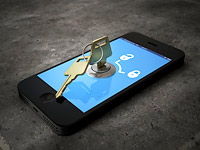
Protecting your smartphone and avoiding identity theft - scams
- Select a language for the TTS:
- UK English Female
- UK English Male
- US English Female
- US English Male
- Australian Female
- Australian Male
- Language selected: (auto detect) - EN
Play all audios:

After Santa delivers that prized holiday must-have to you or a loved one — a smartphone — expect trouble to come calling. As a mini-computer that can store sensitive data, it will be a gold
mine of opportunity for identity thieves. But that's not the only reason why smartphones are increasingly targeted for hacking. Unlike traditional computers, they're always with
you, and messages that arrive on them are more trusted than traditional email and landline phone calls. Studies indicate that smartphone owners are three times more likely to fall for
identity-stealing "phishing" scams than those sent to a PC or Mac. Lock your smartphone screen with a PIN — only one in three users does this. Volker Moehrke/Corbis And use of
smartphone security software remains rare. Already, one in 14 smartphone owners has been a victim of ID theft — a 30 percent higher rate than the general public, according to a 2012 study by
fraud tracker Javelin Strategy & Research. With those numbers expected to jump in the new year, here are 10 ways to protect your new (or already used) smartphone. 1. If you're
still shopping, know that experts consider the iPhone and Windows Phone 7 to have the most secure operating systems. Next comes BlackBerry, with Android having the least secure operating
system. 2. Read the owner's manual to understand the phone's features, including default settings. Turn off or disable unnecessary features to minimize the number of potential
entryways that hackers can use, suggests the FBI. 3. If your phone offers encryption, use it to protect stored data in case of loss or theft. 4. Lock its screen with a PIN — only one in
three smartphone users does this. Don't use your birthdate or birth year, or any of these most commonly used (and hackable) PINS: 1234, 0000, 2580 (a top-to-bottom keypad sequence),
1111, 5555, 5683 (which spells "love"), 0852 (a bottom-to-top sequence), 2222, 1212 and 1998. 5. An app that will track and report the location of your phone is useful and may help
police recover it if it's stolen. Apple's iPhone has the "Find My iPhone" app built in, but you need to activate it; apps such as "Where's My Droid" are
available for Android devices.
